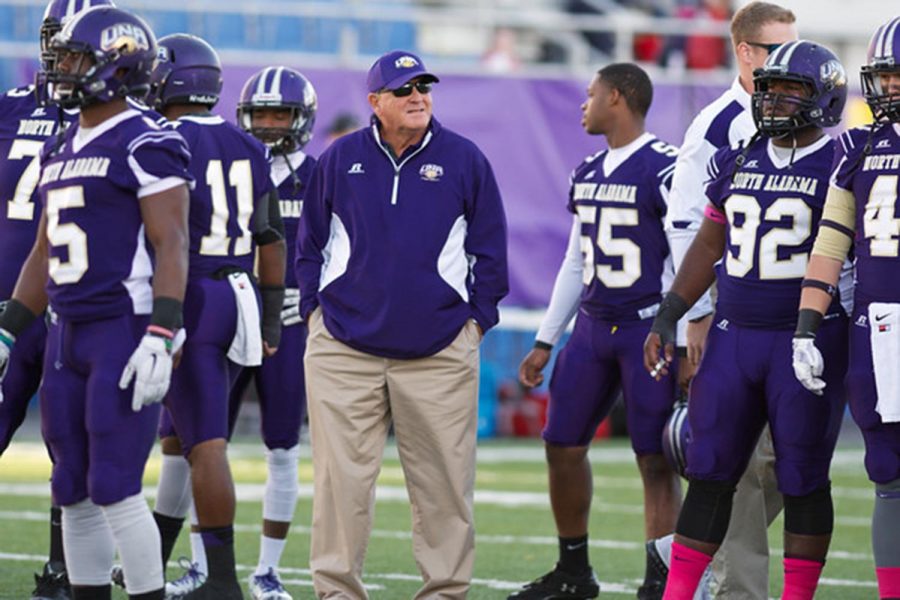AD explains how D-I transition will affect coach pay, athlete scholarships
January 8, 2015
Since the discussion about a transition to Division-I began, UNA Athletics has made several strides toward the shift.
Fundraising has taken off, initial discussions with conferences have begun, and a new weight room facility and two women’s sports have been added.
Next on the to-do list is finding a conference home, and Athletic Director Mark Linder identified the Atlantic Sun Conference and the Big South Conference as possibilities.
“We have to be sensible to the geographical fit, so the conferences in our communication strategy would be in the southern tier of the U.S.,” Linder said. “There’s nothing concrete now.”
If an invitation comes from the Atlantic Sun, which does not include football teams, another conference, such as the Big South, will be sought to house the UNA program.
The football team will join the Football Championship Subdivision, or D-I AA, while the other sports will be considered D-I.
Several steps in the transition to D-I will come after an invitation is received and the move begins, Linder said.
While UNA spends about $957,000 on coach pay annually, D-I Jacksonville State University pays about $2 million.
Linder said he expects UNA will increase spending on coaching salaries by about $800,000 to $1 million as part of the transition.
“We don’t have to spend a certain amount,” Linder said. We don’t have to hire more coaches or increase pay.”
However, he said, to have success, UNA’s coaches will have to be paid salaries similar to those of others in the conference to attract the best ones.
Freshmen Sierra Johnson and Anastasia Holland said the extra expense to ensure UNA has the best coaches is worth the cost.
“I just want our school to be D-I,” Johnson said. “I want us to have a good football team, and spending the money for better sports teams makes the whole college look better.”
Holland said the increase in salary spending is higher than she expected, but feels UNA will benefit from successful sports teams.
Linder said UNA already meets the D-I minimum in coaching salaries and athletic scholarships, and research has been conducted about potential conferences to determine how much to increase in the future.
Schools that transition to D-I do not become conference active until a four-year transition period has passed, meaning they are ineligible to compete for championships during that time.
Linder said during that time, a five-year contract would be extended to coaches, and the pay increases would come later.
He also said the increases would be adjusted to consider cost of living in Florence as compared to cities where coaches from other schools live.
Linder said athletic scholarships are also part of the formula for a successful athletic program, and while UNA is at the top of scholarship funding at the Division-II level, he expects spending will increase by about $1 million to bring scholarships to a higher level at D-I.
Tuition increases were considered in the estimates, he said.
“For example, in women’s basketball D-I has 15 full scholarships and in D-II, we only have 10,” he said “So, we’re at the minimum, but we don’t want to be at the minimum because we won’t be competitive. We want to be good in our sports.
“As far as a D-II school, UNA is on very solid footing to make the transition, so that will make it easier for us as we move to D-I.”
Linder said fundraising for the transition began when the university set a benchmark of $3 million.
He said the goal was reached through pledges from community members.
“Of course we are still collecting those pledges, so we don’t have all of that in the bank yet,” he said. “But, that goes to show the community supports the move.”
The university will also foot a portion of the cost, as the board of trustees capped the spending on athletics at 4 percent of the university’s general fund budget, although scholarships for athletes are not included in that limit.
Linder said the athletic department is not expected to bring the university a profit.
“Very few schools actually make money from athletics,” he said. “The cap on funding protects the institution from taking money away from academics.
Holland said the cap was a smart move by the trustees.
“My high school spent lots of money on sports, and there’s way more important stuff to consider,” she said.
Sophomore Jose Figueroa-Cifuentes said he expects the transition to D-I will benefit UNA by increasing enrollment and helping build the university’s name recognition.


